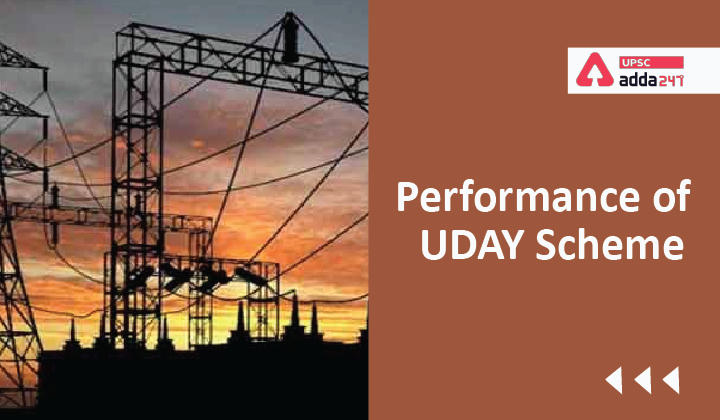Table of Contents
UDAY Scheme: Relevance
- GS 3: Infrastructure: Energy, Ports, Roads, Airports, Railways etc.
UDAY Scheme: Context
- Recently, Union Minister of Power has said in Rajya Sabha that UDAY scheme did not met its stated objectives.
UDAY Scheme: Key points
- The Minister said that private sector power distribution companies (discoms) improved efficiency levels faster than state-owned discoms under UDAY scheme between FY16 and FY20.
- The Minister has also said that discoms have faced mounting debt due to large accumulated losses and have repeatedly required financial support through government schemes.
- He also informed that state utilities have reported a fall in average reduction in (AT&C) losses to 21% in FY20 from 23.7% in FY16 and a reduction in the ACS-ARR gap to Rs 0.30 per kWh in FY20 from Rs 0.48 per kWh in FY16.
- UDAY scheme was aimed at reducing aggregate technical and commercial (AT&C) losses for discoms to 15% and to reduce the gap between average cost of power supply and average revenue realised (ACS-ARR gap) per unit (1 unit = 1 kilowatt hour) to zero.
- UDAY was aimed at providing a permanent resolution to the financial issues in the power sector, but did not meet its stated objectives.
- It led to government announcing a new Rs 3.03-lakh crore incentive-based reform scheme for discoms earlier this year with similar operational targets to be achieved by FY25.
About UDAY scheme
- In 2015, Ministry of Power had launched Ujwal DISCOM Assurance Yojana (UDAY) to achieve the following objectives in the power sector:
- Financial Turnaround
- Operational improvement
- Reduction of cost of generation of power
- Development of Renewable Energy
- Energy efficiency & conservation
UDAY Scheme: Salient features
- States will take over 75% of the DISCOM debt as on Sept 30, 2015 – 50% in FY 2015-16 and 25% in FY 2016-17.
- States to issue non-SLR including SDL bonds, to take over debt and transfer the proceeds to DISCOMs in a mix of grant, loan, equity.
- Maturity period of bonds – 10-15 years.
- Moratorium period – up to 5 years.
- Rate – G-sec plus 0.5% spread plus 0.25% spread for non-SLR.
- Borrowing not to be included for calculating fiscal deficit of the State.
UDAY: Targeted activities
| Activity | Expected date for achievement |
| Feeder Metering | 30 June 2016 |
| DT Metering | 30 June 2017 |
| Consumer indexing & GIS Mapping | 30 Sept 2018 |
| Upgradation of DT, Meters etc | 31 Dec 2017 |
| Smart meter for consumers | > 500 Unit by Dec 17; >200 unit by Dec 2019 |
| AT&C losses | 15% by FY 2019 |
| Elimination ACS-ARR gap | FY 2019 |
UDAY scheme: Benefits to Participating States
- Increased supply of domestic coal
- Allocation of coal linkages at notified prices
- Coal price rationalization
- Coal linkage rationalization & allowing coal swaps
- Supply of washed & crushed coal
- Additional coal at notified prices
- Faster completion of Interstate Transmission lines
- Power purchase through transparent competitive bidding
Also Read:





 TSPSC Group 1 Question Paper 2024, Downl...
TSPSC Group 1 Question Paper 2024, Downl...
 TSPSC Group 1 Answer key 2024 Out, Downl...
TSPSC Group 1 Answer key 2024 Out, Downl...
 UPSC Prelims 2024 Question Paper, Downlo...
UPSC Prelims 2024 Question Paper, Downlo...
